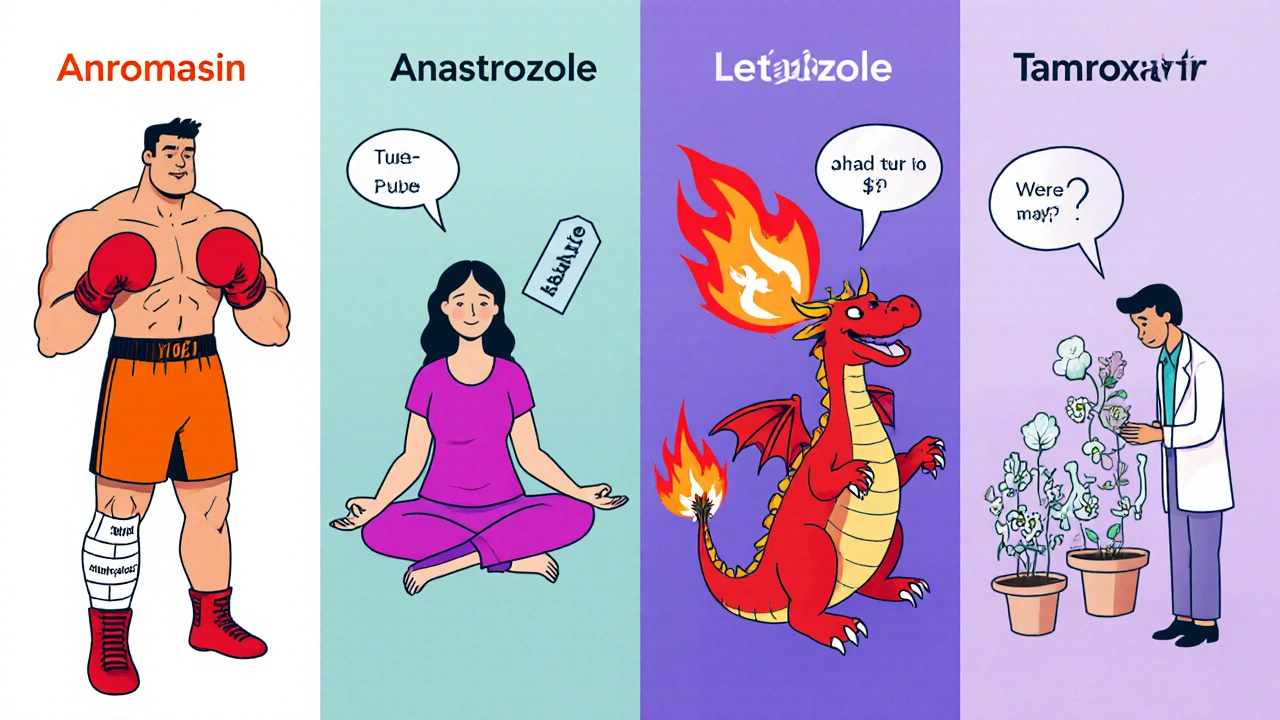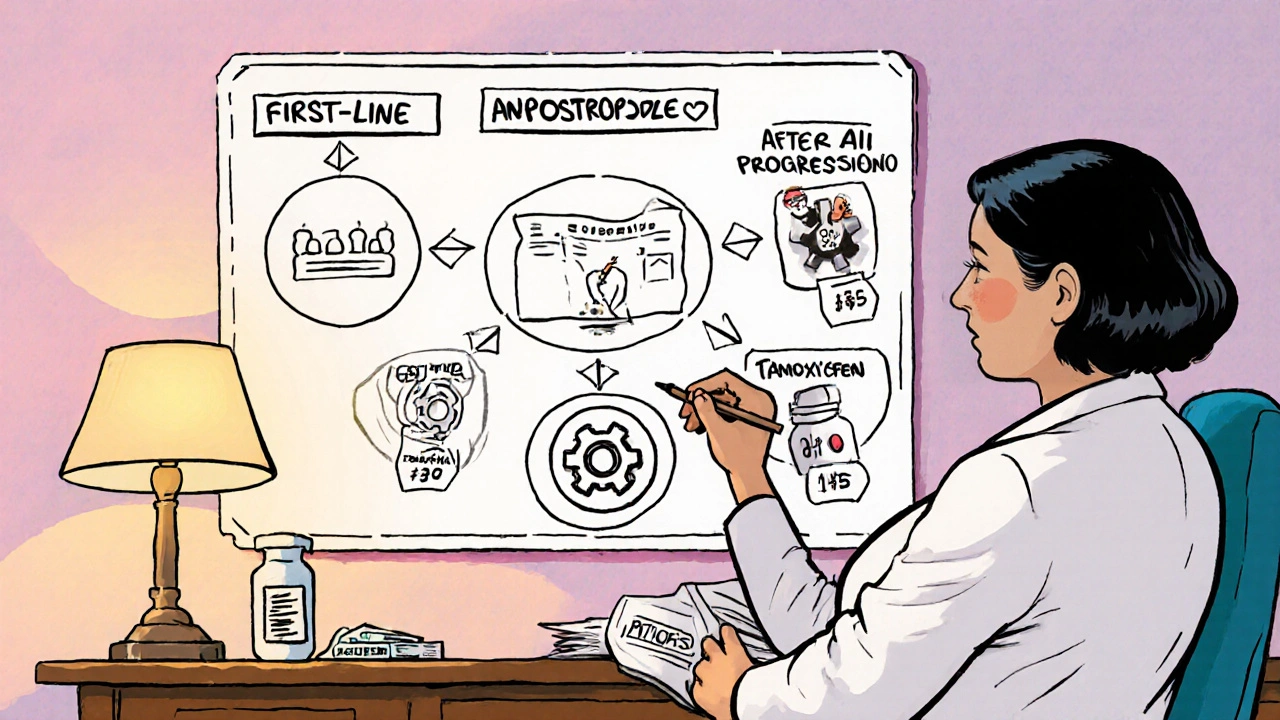Aromatase Inhibitor Decision Tool
Choose the best aromatase inhibitor for your specific situation based on disease stage, side effect tolerance, and treatment history.
Your Situation
When it comes to managing estrogen‑driven conditions, especially hormone‑responsive breast cancer, choosing the right aromatase inhibitor can feel like a high‑stakes puzzle. Aromasin is the brand name for Exemestane, a steroidal aromatase inhibitor that’s been on the market since 1999. It works by permanently deactivating the aromatase enzyme, cutting estrogen production at the source. But is it always the best pick? Below we stack Aromasin against its most common rivals-Anastrozole, Letrozole, and Tamoxifen-so you can see exactly where each shines and where it falls short.
Why Aromasin (Exemestane) Exists
Exemestane belongs to the steroidal class of aromatase inhibitors, sometimes called “type I” inhibitors. Unlike non‑steroidal agents that reversibly bind to aromatase, Aromasin forms a covalent bond, essentially knocking the enzyme out for the life of the drug molecule. This irreversible action can translate to a steadier suppression of estrogen, which is why many oncologists reserve it for patients who have progressed on other aromatase inhibitors.
Key Alternatives to Consider
- Anastrozole (Arimidex) - a non‑steroidal, reversible inhibitor widely used as first‑line therapy.
- Letrozole (Femara) - another non‑steroidal inhibitor, often favored for its slightly higher potency.
- Tamoxifen (Nolvadex) - a selective estrogen receptor modulator (SERM) that blocks estrogen receptors instead of stopping its production.
Comparison Table: Aromasin vs. Alternatives
| Drug | Class | Mechanism | Typical Dose | Key Pros | Key Cons |
|---|---|---|---|---|---|
| Aromasin (Exemestane) | Steroidal AI | Irreversible aromatase binding | 25 mg once daily | Long‑lasting estrogen suppression; useful after AI failure | Higher risk of joint pain; modest effect on bone density |
| Anastrozole (Arimidex) | Non‑steroidal AI | Reversible aromatase inhibition | 1 mg once daily | Well‑tolerated; low cost; easy dosing | May lose potency over time; less effective after progression |
| Letrozole (Femara) | Non‑steroidal AI | Reversible, high‑affinity aromatase binding | 2.5 mg once daily | Strongest estrogen knockdown among oral AIs | Higher incidence of hot flashes and bone loss |
| Tamoxifen (Nolvadex) | SERM | Blocks estrogen receptors in breast tissue | 20 mg once daily | Protects bone; reduces cholesterol | Increases risk of endometrial cancer; less effective for advanced disease |

How to Pick the Right Option
Choosing the best drug depends on three practical factors: disease stage, side‑effect tolerance, and treatment history.
- First‑line therapy: For most post‑menopausal patients with early‑stage hormone‑positive breast cancer, non‑steroidal AIs like Anastrozole or Letrozole are preferred because they’re proven to reduce recurrence risk.
- After AI progression: If a tumor becomes resistant to a non‑steroidal AI, switching to Aromasin can recapture response because it hits the enzyme from a different chemical angle.
- Bone health concerns: Tamoxifen actually helps maintain bone density, making it a smarter choice for patients with osteoporosis or at high fracture risk.
Side‑Effect Profiles at a Glance
All aromatase inhibitors lower estrogen, which inevitably brings a set of predictable side effects. Here’s how the four drugs compare on the most common complaints.
- Joint and muscle pain: Reported by 30‑40 % of Aromasin users; slightly lower for Anastrozole (≈25 %).
- Hot flashes: Letrozole tops the list (≈45 %); Tamoxifen causes fewer hot flashes but introduces menstrual‑type symptoms.
- Bone mineral density loss: Both non‑steroidal AIs and Aromasin can accelerate bone loss; Tamoxifen may actually improve BMD in post‑menopausal women.
- Gastro‑intestinal upset: Rare across the board, though Letrozole occasionally triggers mild nausea.
Drug Interactions and Practical Considerations
Because Aromasin is a steroidal molecule, it’s metabolized by the CYP3A4 pathway. Strong CYP3A4 inducers (e.g., rifampin, carbamazepine) can lower Exemestane levels, potentially weakening its effect. On the flip side, CYP3A4 inhibitors (e.g., ketoconazole) may raise drug concentrations, increasing the risk of arthritis‑like pain.
Non‑steroidal AIs are also CYP3A4 substrates, but they’re less sensitive to modest enzyme fluctuations. Tamoxifen, meanwhile, is metabolized by CYP2D6; patients who are poor CYP2D6 metabolizers see reduced efficacy.

Cost Snapshot (2025 USD)
Price can be a deciding factor, especially when insurance coverage varies.
- Aromasin: $120‑$150 for a 30‑day supply (brand) or $40‑$60 for generic Exemestane.
- Anastrozole: $15‑$30 per month (generic).
- Letrozole: $30‑$45 per month (generic).
- Tamoxifen: $10‑$20 per month (generic).
When you factor in monitoring costs (bone density scans, lipid panels), the overall budget can shift dramatically.
Quick Takeaways
- Aromasin offers an irreversible shut‑off of estrogen production, making it valuable after other AIs fail.
- Anastrozole and Letrozole are first‑line favorites because they’re cheap, well‑tolerated, and backed by large trials.
- Tamoxifen is the go‑to when bone health or menopausal symptoms are major concerns.
- Watch for CYP 3A4 interactions with Aromasin; adjust doses or choose another AI if you’re on strong inducers.
- Overall cost differences are modest, but insurance formularies can push patients toward the least expensive generic.
Frequently Asked Questions
Can I switch from Anastrozole to Aromasin without a washout period?
Yes. Because both drugs act on the same enzyme but through different mechanisms, clinicians usually transition directly. Monitoring estrogen levels for a week after the switch helps confirm adequate suppression.
Is Aromasin safe for pre‑menopausal women?
Aromasin is only approved for post‑menopausal patients. In pre‑menopausal women, the body compensates by producing more ovarian estrogen, so the drug’s effect is minimal and can cause hormonal imbalance.
How does Aromasin affect bone density compared to Letrozole?
Both can reduce bone mineral density, but studies show Letrozole causes slightly greater loss (average 2‑3 % per year) versus Aromasin’s 1‑2 %. Patients on either should have a DEXA scan at baseline and annually.
Do I need to take calcium supplements with Aromasin?
Supplementing with calcium (1,000 mg) and vitamin D (800 IU) is recommended for all aromatase inhibitors to mitigate bone loss, regardless of which agent you pick.
Which drug has the lowest risk of hot flashes?
Tamoxifen typically causes fewer hot flashes because it blocks estrogen in breast tissue while acting as a weak estrogen agonist in the brain. Among AIs, Aromasin reports the lowest hot‑flash incidence, but the difference is modest.





Ekeh Lynda
A thorough read of the comparison reveals glaring omissions. The analysis fails to address real‑world adherence issues. It glosses over the economic burden on low‑income patients. Moreover the side‑effect discussion is superficial at best. The claim of “steady suppression” ignores pharmacokinetic variability. In practice clinicians see mixed outcomes that the article conveniently overlooks.
Mary Mundane
Overall the piece feels like a generic marketing brochure.
Michelle Capes
I get why the author wanted to map out the options 😊 but some of the data could be clearer. A few typos slipped through, like “reversibly” spelled “reversablly”. Still, the effort to simplify a complex topic is appreciated. Hope future updates include more patient‑centric anecdotes.
Dahmir Dennis
One would think that presenting a “detailed comparison” would entail some intellectual honesty, yet the author merely regurgitates textbook clichés. The sarcasm is palpable when the text lauds Aromasin’s “irreversible shutdown” without mentioning the ethical implications of pushing patients into higher joint pain risk. It’s almost as if the writer assumes we have no agency to question pharmaceutical hegemony. By ignoring the socioeconomic disparities that dictate drug choice, the article betrays a naive optimism. Ultimately, readers are left with a polished sheet that skirts the moral weight of prescribing decisions.
Jacqueline Galvan
Thank you for your candid observation. While brevity can be valuable, the article aimed to provide a balanced overview for both clinicians and patients. It is essential to maintain an evidence‑based tone while acknowledging individual preferences. I hope this clarification adds depth to the discussion.
Tammy Watkins
In the realm of endocrine oncology, the selection of an aromatase inhibitor constitutes a decision of profound clinical consequence. The pharmacodynamic profile of Exemestane, characterized by its irreversible binding to the aromatase enzyme, distinguishes it from reversible agents such as Anastrozole and Letrozole. This covalent inhibition translates into a sustained attenuation of estrogen synthesis, a property that can be pivotal when faced with tumor progression on first‑line therapy. Moreover, the steroidal backbone of Aromasin confers a unique metabolic pathway, rendering it less susceptible to certain cytochrome‑mediated drug–drug interactions. Nonetheless, clinicians must remain vigilant regarding the heightened incidence of arthralgia and potential impacts on bone mineral density, especially in patients with pre‑existing osteopenia. Evidence from phase‑III trials demonstrates that, after failure of non‑steroidal agents, a switch to Exemestane can restore clinical response in a subset of individuals, underscoring its strategic utility. From a cost‑effectiveness perspective, the availability of generic Exemestane mitigates financial barriers, yet insurance formularies may still favor cheaper non‑steroidal options, compelling practitioners to navigate bureaucratic complexities. Patient adherence is further influenced by the once‑daily dosing schedule, which aligns with routine medication regimens and reduces pill burden. It is incumbent upon the treating oncologist to integrate bone health assessments, such as baseline DEXA scans, into the therapeutic algorithm when prescribing any aromatase inhibitor. Supplementation with calcium and vitamin D, coupled with lifestyle modifications, can ameliorate skeletal risks. In comparison, Letrozole, while exhibiting marginally greater estrogen suppression, bears a higher propensity for vasomotor symptoms, thereby affecting quality of life. Tamoxifen, although beneficial for bone preservation, lacks the potency required for advanced metastatic disease, positioning it as a secondary rather than primary choice in many protocols. The decision matrix must also account for CYP3A4 inducers or inhibitors that could attenuate or amplify drug exposure, respectively. Ultimately, the clinician’s judgment, informed by tumor biology, comorbid conditions, and patient preferences, orchestrates the optimal selection of therapy. I trust that this comprehensive exposition clarifies the nuanced considerations essential to individualized treatment planning.
Dawn Bengel
Wow, an American‑centric view of drug costs! 🇺🇸 It’s absurd that you praise “generic” options when many patients here can’t even afford the brand name. The focus on “strategic utility” sounds like corporate propaganda. 😒
junior garcia
Culture shapes how we view side effects, but the pain is universal.
Dason Avery
Indeed, the human experience transcends borders 😊. Yet each healthcare system adds its own layer of complexity.
Casey Morris
Ah, dear interlocutor, what a delight-indeed, the discourse surrounding aromatase inhibition is rife with nuance; one must, of course, consider the pharmacokinetic parameters, the epidemiological data, and the ethical ramifications, all whilst maintaining a cordial demeanor. Truly, the literature beckons us to delve deeper, does it not?